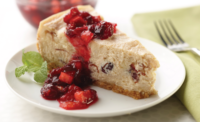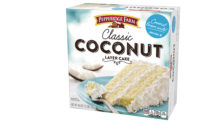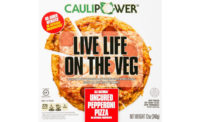Let them eat cake … and pies, and cheesecake. Consumers are still seeking indulgent multi-sensory experiences and desserts deliver. Dataessential, Chicago reports that dessert incidence remains high, with 93 percent of respondents stating they ate dessert within the past week.
However, consumer interest in healthier options throughout the day could impact the dessert category. But with the right approaches toward better-for-you formulations, bakers can capitalize on this shifting market.
Overview | Bread | Tortillas | Sweet Goods | Snack Cakes | Pizza | Desserts | Cookies | Buns & Rolls | Bars | Breakfast Products
Market data
Data from IRI, Chicago shows a 5.1 percent drop in sales for the pies and cakes category to $1.9 billion, based on the latest 52-week period ending March 24, 2019. Cakes were down 5.9 percent, dropping to $1.4 billion. Private label, which accounts for over 63 percent of the category, experienced a significant drop of 12.6 percent, declining to $917.8 million. But there are bright spots in the category:
- Café Valley Bakery grew 12.5 percent to $52.8 million
- CMS Bakery Products grew 14.4 percent to $37.0 million
- Rich Products Corp. grew 22.3 percent to $20.7 million
Niche Bakers Corp. made the top 10 companies this year with a particularly strong performance, up 190.2 percent to $24.5 million in sales.
The pie category also saw a decline, dropping 2.3 percent to $430.7 million. Private label, which represents over 70 percent of the market, contributed to the decline, falling 4.7 percent to $302.9 million. Offsetting some of the decline was Jesse Lord Bakery, which grew 8.9 percent to $31.4 million. Table Talk Pies—which includes snack-sized pies in its product lineup—has seen significant growth of 249.3 percent to $20.6 million, up from $5.9 million as of this time last year.
Frozen pies also dipped 1.9 percent, dropping to $491.3 million. The top two players in the category, Schwan’s and Conagra, account for over 86 percent of the market. While Schwan’s sales grew 2.6 percent over the period, increasing to $240.1 million, Conagra sales dropped 10.0 percent to $184.1 million. Private label experienced another year of growth, increasing 56.1 percent to $19.9 million.
The refrigerated cheesecakes segment was the only area that demonstrated overall growth, up 4.5 percent to $320.5 million. This category continues to show strong, year-over-year growth. Private label, which is the category leader, grew 3.6 percent to $186.5 million. The Father’s Table was up 7.6 percent to $60.9 million.
Looking back
According to Laura Bergan, director of marketing, innovation and specialties, Barry Callebaut, Chicago, the dessert category is being pulled in two different directions. One is geared toward the premium space, with higher-end products, often going more decadent with prominent use of real chocolate. The company has noted an increased demand for real chocolate used in desserts and pastries. The other is a trend toward slightly healthier, better-for-you options, including free-from bakery niches like gluten-free and dairy-free, as well as products with higher protein and/or reduced sugar.
In response to the demand for these options, Barry Callebaut has launched several new high-protein and reduced-sugar products. The company launched Ecl1pse, a genuine Belgian milk chocolate with only 1 percent added sugar and no soy or artificial ingredients. “Ecl1pse also has about twice the milk and cocoa content, making it smoother, darker, more intense and creamier than other milk chocolate. Plus, this allows chefs to reduce the sugar content in their desserts by 20 to 50 percent,” says Bergan.
Bergan notes that the new High-Protein Chocolates, containing at least 25 percent protein, are available in liquid or small drops in various forms. Three are made with whey protein: dark chocolate, milk chocolate and dark chocolate without added sugar. Another dark chocolate is vegan, made with pea protein. These protein-rich chocolate ingredients work well as inclusions or as an enrobing material.
According to data shared by Hershey Foodservice, Hershey, PA, 35 percent of consumers are more interested in trying new flavors now than in 2016, and foodservice operators are interested in delivering on these trends. The Hershey Foodservice Culinary Team notes that across all categories—from independent, smaller, fine-dining establishments to mature, quick-service and mid-scale restaurants—ethnic flavors and global dessert offerings continue to be on the rise.
The Hershey team also notes seeing new flavors and ingredients being used for cheesecakes. Goat cheese and mascarpone are seeing growth on independent cheesecake menus, while ricotta is growing on chain menus. Similarly, use of coulis is growing at independents while compote is growing at chains.
Consumers also are demanding cleaner-label products. Hershey Foodservice is responding, and will be launching Hershey’s SIMPLY Syrup, made with simple ingredients and without artificial preservatives, sweeteners, flavors or colors. The new syrup can be used in the same applications where the traditional chocolate syrup is used, including bakery applications.
Unifiller Systems Inc., Delta, British Columbia, notes that cake manufacturers are looking for increased operational efficiencies, while also being able to deliver new and unique flavors and visuals that help differentiate them from the competition. “With the bakery industry currently facing a shortage of skilled labor due to an aging workforce, fewer people entering the trade, and a lack of trained candidates, dessert producers are looking for other ways to ensure consistent manufacturing capabilities,” states Sonia Bal, director, marketing and sales operations.
The company has addressed these issues in its new CakeStation machine. “This all-in-one system was designed specifically to address the needs of cake manufacturers looking to do more with their equipment,” says Bal. “Bakers will be able to deposit batters, assemble cakes, mid-fill, ice sides and the tops of cakes, and decorate with rosettes or borders—all in one machine. The CakeStation’s PLC touchscreen control system with recipe storage will drastically reduce changeover time. Bakers can quickly finish cakes with a pre-determined amount of icing, limiting operator error and ensuring consistent results every time.”
Columbus Vegetable Oils, Des Plaines, IL, recently designed several new shortening ingredient formulas that provide improved whipping and emulsification for bakeries. “These products are all trans-fat-free fats and oils based off of palm oil fractions, interesterified vegetable oils and a variety of emulsifier options to meet the particular requirements for each application and customer. Typically, the primary difference of these new shortenings falls to the level of the various emulsifiers that may be used, and also a balance of the hard and soft oil fractions to get the desired product texture or temperature range,” says Rick Cummisford, director of quality. These new ingredients can be used in applications like frostings, fillings and similar products.
Looking forward
Barry Callebaut believes that the free-from and better-for-you trends will continue to impact the dessert category. “Organic is no longer a trend, it has become a lifestyle. Today’s consumer will likely have some sort of restriction around what they eat, whether it is gluten-, dairy- or sugar-free. Moreover, increasing numbers of people adopt vegan, vegetarian or flexitarian diets, trying to diversify their sources of protein beyond meat,” notes Bergan. Most recently the company has launched their Pathway range, a line of dairy-free chocolates offered in both dark and “milk-like” flavors. The “milk-like” products are lighter in color and provide a “milkier” type of flavor profile to closely mimic the flavor of a milk chocolate. These Pathway coatings and inclusions offer sweet and decadent flavor profiles and address the demand for more dairy-free options.
Hershey Foodservice notes consumers will continue to seek out new taste and flavor experiences. “As global flavors continue to penetrate the industry, we believe their importance will sustain into the future of desserts. Bold flavors or exotic fruit offerings that originate with chefs will make their way to more mainstream restaurants over time—as with any trend, it starts small and gains momentum,” says Jenna N. Kolanda, corporate chef, Hershey Foodservice.
Consumers will always be interested in indulgent taste experiences, and desserts deliver. However, with consumers looking for healthier options, this will create opportunities for new, better-for-you products to grow the category. Going forward, there may be a blend of the best of both worlds, so you can have your cake and also feel good about eating it, too.
Overview | Bread | Tortillas | Sweet Goods | Snack Cakes | Pizza | Desserts | Cookies | Buns & Rolls | Bars | Breakfast Products









